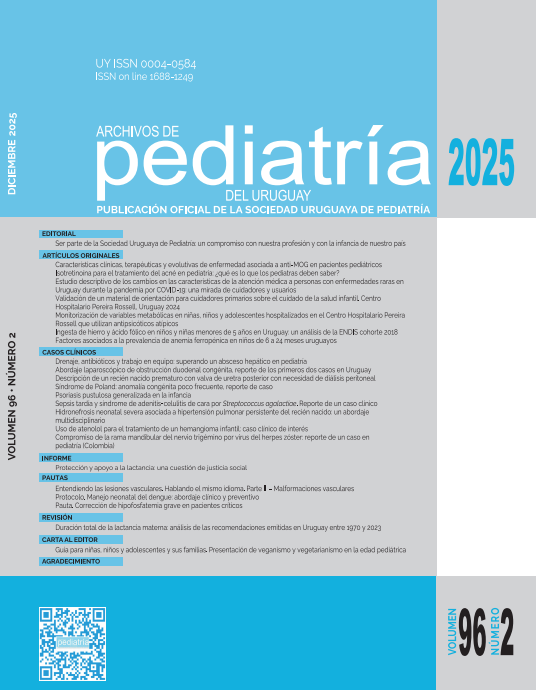Abstract
Introduction: the consumption of psychotropic drugs, particularly antipsychotics, has been increasing globally in children and adolescents (NNA). In our country, there are few studies on the subject, but they show a high level of use of these drugs. Atypical antipsychotics are associated with metabolic alterations such as dyslipidemia, diabetes, and overweight/obesity, among others.
Objectives: describe clinical and paraclinical metabolic variables in NNA using atypical antipsychotics, admitted to moderate care wards at the Pereira Rossell Hospital Center, during the period of July - September 2022.
Methodology: an observational, cross-sectional, descriptive study was conducted, including patients aged 2-15 years. Pharmacological, anthropometric, and biochemical data were obtained. Physical activity and dietary quality were evaluated. The PSPP statistical software version 3 was used. The study was approved by the Research Ethics Committee of the Pereira Rossell Hospital Center (CHPR).
Results: fifty-three NNA were included, with a median age of 13 years. Risperidone, quetiapine, and aripiprazol were the most commonly used. Thirty percent presented overweight/obesity, 50% were sedentary, and 30% had unhealthy eating habits. Twenty-one NNA had had the recommended blood biochemichal tests used to monitor these drug users.
Conclusions: metabolic alterations were found in more than half of the included subjects. Risperidone remains the most prescribed antipsychotic in this population, with a growing use of aripiprazol. Polypharmacy persisted as a prescription problem in these patients.
References
Alessi S, Biscontri R, Collins D, Sareen J, Enns M. Ten years of antipsychotic prescribing to children: a Canadian population-based study. Can J Psychiatry 2012; 57(1):52-8. doi: 10.1177/070674371205700109.
Gatell A, García A, Vedia C, Bruna X, Morales V, Gómez A. Uso de psicofármacos en población pediátrica europea. Rev Pediatr Aten Primaria 2020; 22(28):46. Disponible en: https://scielo.isciii.es/scielo.php?script=sci_arttext&pid=S1139-76322020000200046. (Consulta: 8 octubre 2023).
Mastroianni M, Ackermann C, Speranza N, Catenaccio V, Telechea H, Giachetto G, et al. Características del uso de psicofármacos en niños hospitalizados. Arch Pediatr Urug 2017; 88(3):132-41. Disponible en: http://www.scielo.edu.uy/scielo.php?script=sci_arttext&pid=S1688-12492017000300132&ln%20g=es. (Consulta: 9 octubre 2023).
Barrios A, Barrios S, Behrens H, Bentos C, Di Caterina X, Maurente L, et al. Politerapia en niños y adolescentes hospitalizados en cuidados moderados en el Hospital Pediátrico del Centro Hospitalario Pereira Rossell (julio-setiembre 2019). Arch Pediatr Urug 2020; 91(4):207-24. doi: 10.31134/ap.91.4.3.
Asociación Española de Pediatría. Comité de Medicamentos. Pediamécum: Aripiprazol. Madrid: AEP, 2021. Disponible en: https://www.aeped.es/comite-medicamentos/pediamecum/aripiprazol. (Consulta: 9 octubre 2023).
Asociación Española de Pediatría. Comité de Medicamentos. Pediamécum: Risperidona. Madrid: AEP, 2020. Disponible en: https://www.aeped.es/comite-medicamentos/pediamecum/risperidona. (Consulta: 8 octubre 2023).
Pillinger T, McCutcheon R, Vano L, Mizuno Y, Arumuham A, Hindley G, et al. Comparative effects of 18 antipsychotics on metabolic function in patients with schizophrenia, predictors of metabolic dysregulation, and association with psychopathology: a systematic review and network meta-analysis. Lancet Psychiatry 2020; 7(1):64-77. doi: 10.1016/S2215-0366(19)30416-X.
Pozzi M, Ferrentino R, Scrinzi G, Scavone C, Capuano A, Radice S, et al. Weight and body mass index increase in children and adolescents exposed to antipsychotic drugs in non-interventional settings: a meta-analysis and meta-regression. Eur Child Adolesc Psychiatry 2022; 31(1):21-37. doi: 10.1007/s00787-020-01582-9.
Nicol G, Yingling M, Flavin K, Schweiger J, Patterson B, Schechtman K, et al. Metabolic effects of antipsychotics on adiposity and insulin sensitivity in youths: a randomized clinical trial. JAMA Psychiatry 2018; 75(8):788-96. doi: 10.1001/jamapsychiatry.2018.1088.
Whicher C, Price H, Holt R. Mechanisms in endocrinology: antipsychotic medication and type 2 diabetes and impaired glucose regulation. Eur J Endocrinol 2018; 178(6):R245-58. doi: 10.1530/EJE-18-0022.
Delacrétaz A, Vandenberghe F, Glatard A, Dubath C, Levier A, Gholam M, et al. Lipid disturbances in adolescents treated with second-generation antipsychotics: clinical determinants of plasma lipid worsening and new-onset hypercholesterolemia. J Clin Psychiatry 2019; 80(3):18m12414. doi: 10.4088/JCP.18m12414.
Sjo C, Stenstrøm A, Bojesen A, Frølich J, Bilenberg N. Development of metabolic syndrome in drug-naive adolescents after 12 months of second-generation antipsychotic treatment. J Child Adolesc Psychopharmacol 2017; 27(10):884-91. doi: 10.1089/cap.2016.0171.
Uruguay. Comisión Honoraria para la Salud Cardiovascular. Enfermedades cardiovasculares. Semana del Corazón 2022. Disponible en: https://semanadelcorazon.com.uy/2022/enfermedades-cardiovasculares/. (Consulta: 8 octubre 2023).
Tabárez A, Köncke F, Borrat F, Pérez F, Areal R, Méndez V. Obesidad e insulinorresistencia en un grupo de niños que se asisten en el Centro Hospitalario Pereira Rossell. Arch Pediatr Urug 2007; 78(1):59. Disponible en: http://www.scielo.edu.uy/scielo.php?script=sci_arttext&pid=S1688-12492007000100012. (Consulta: 9 abril 2022).
Graña J, Burgueño A, Olivera C, Casella B, Cáceres M, Piquerez M, et al. Primer trabajo comunitario de prevención cardiovascular en pediatría en Lascano. Arch Pediatr Urug 2009; 80(2):77-89. Disponible en: http://www.scielo.edu.uy/scielo.php?script=sci_arttext&pid=S1688-12492009000200002. (Consulta: 9 abril 2022).
Estragó V, Tabárez A, Muñóz M, González G, Bulla D, Díaz J, et al. Sobrepeso, obesidad e hipertensión arterial en niños, una aproximación al problema. Arch Pediatr Urug 2018; 89(5):301-10. doi: 10.31134/ap.89.5.2.
Bove M, Giachetto G, Ramírez R, Zelmonovich C, Guillermo V, Klaps L, et al. Sobrepeso, obesidad y niveles de presión arterial en niños de nivel 5 de jardines de infantes públicos de Montevideo: prevalencia y factores asociados. Rev Méd Urug 2020; 36(3):254-66. doi: 10.29193/RMU.36.3.2.
Assandri E, Casuriaga A, Le Pera V, Notejane C, Vázquez M, Zunino C. Atención pediátrica: normas nacionales de diagnóstico, tratamiento y prevención. 9 ed. Montevideo: Oficina del Libro-FEFMUR, 2020.
Godard C, Rodríguez M, Díaz N, Lera M, Salazar R, Burrows A. Valor de un test clínico para evaluar actividad física en niños. Rev Med Chil 2008; 136(9):1155-62. doi: 10.4067/S0034-98872008000900010.
Machado K, Gil P, Ramos I, Pírez C. Sobrepeso/obesidad en niños en edad escolar y sus factores de riesgo. Arch Pediatr Urug 2018; 89(Supl 1):16-25. doi: 10.31134/ap.89.s1.2.
Morteo A. El uso de psicofármacos en los centros de protección de adolescentes en Montevideo. Psicol Conoc Soc 2018; 8(2):84-97. doi: 10.26864/pcs.v8.n2.7.

This work is licensed under a Creative Commons Attribution 4.0 International License.
Copyright (c) 2025 Archives of Pediatrics of Uruguay


